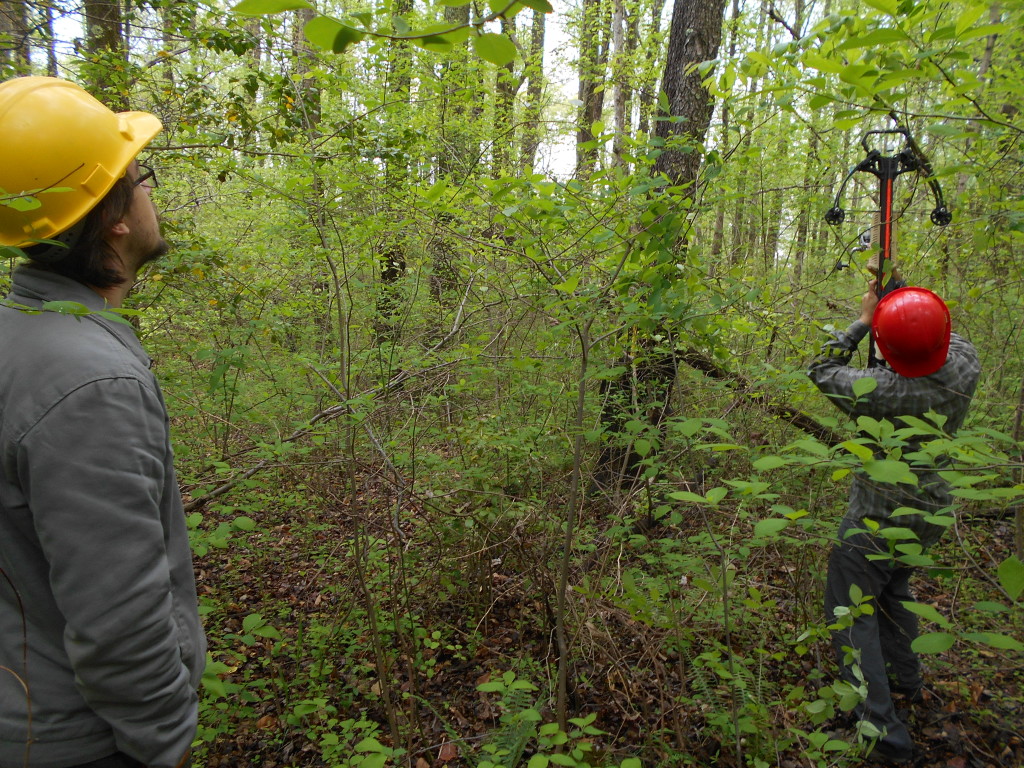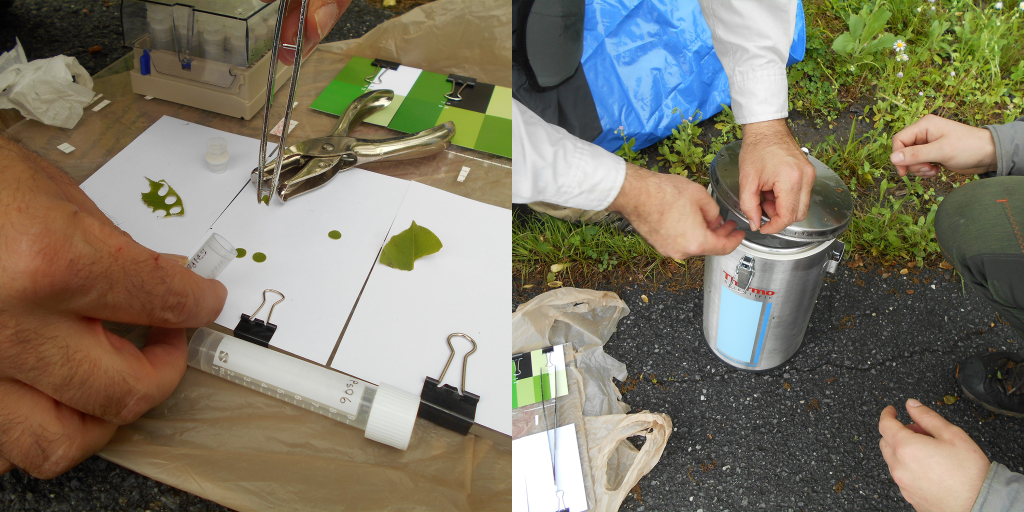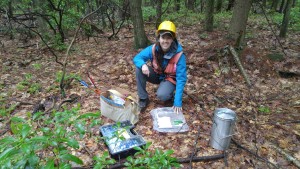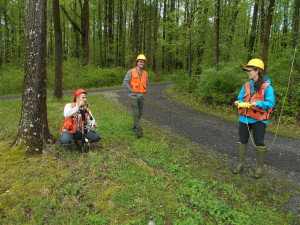That’s why Uzay Sezen carries a crossbow and liquid nitrogen into the forest with him.
by Ryan Greene

Intern Alex Koure (left) and postdoctoral researcher Uzay Sezen (right) are using a crossbow to get leaf samples from hard-to-reach branches. A fishing line attached to the arrows helps them shake down leaves from the canopy. Credit: Ryan Greene/SERC
Uzay Sezen is a new postdoc at the Smithsonian Environmental Research Center (SERC), and he’s on the hunt for good data. Literally.

Uzay Sezen with his crossbow and liquid nitrogen in Harvard Forest. Credit: SERC
With senior scientist Sean McMahon and other members of the Quantitative Ecology Lab, Sezen is embarking on a multiyear study which aims to unveil the genetic patterns of tree growth. Their mission: Find out if tree species present at both SERC and Harvard Forest grow in the same way, and whether there are particular genes they express when they grow. Not only will this help us understand how trees respond to day-to-day changes in sunshine, temperature, and rainfall, but it may provide insight into how forests will react (and already are reacting) to global factors like climate change.
Since about 2009, scientists at SERC have been using metal bands called dendrometers to measure how trees grow (within a hundredth of millimeter!) over years, seasons, weeks, and even days. According to SERC technician Jessica Shue, combining these physical measurements with Sezen’s genetic analysis may help reveal what makes some trees in the forest winners and others losers.
“Now that we can look at the genetics, we can look at a much finer scale at what’s causing some trees to be dominant in the canopy, and others of the same species [to be] stuck in the understory,” she says.
How, though, do you ask a tree which genes it’s using?
The answer is RNA sequencing. Trees have lots of genes, but only some are active at any given time. A molecule called messenger RNA is a good indicator of gene activity because it’s what brings DNA’s “instructions” to the places in the cell where proteins are made. RNA sequencing allows scientists like Sezen to isolate and analyze all the messenger RNA in a sample. This means they can take a leaf from a tree and see which genes were active at a particular moment in time.
This all sounds pretty straightforward: Collect some leaves. Send them to a facility for RNA sequencing. Get on with your analysis. Simple, right?

“We’re finding the ideal tool for every height,” says SERC intern Alex Koure. A pole pruner is best for low leaves, a crossbow handles high leaves, and a water bottle works for everything in between. Credit: Ryan Greene/SERC
Well, not really. There are two problems. First, it’s not always that easy to get leaves. Humans are short, and though some leaves can be cut by a pole pruner, and others can be knocked down by an expertly tossed water bottle, many leaves are simply out of reach. Hence the crossbow—a technique Sezen learned while doing research on palm trees in Costa Rica. By shooting arrows attached to a fishing line, Sezen can drape the line over hard-to-reach branches and shake the leaves down by hand.
The second problem is that RNA tends to degrade quickly. To use RNA sequencing to ask trees what they’re up to, Sezen needs to keep the RNA intact. This is where liquid nitrogen comes in. After collecting the leaves, he immediately puts bits of them in tubes, and then flash-freezes the tubes in a container of liquid nitrogen. This keeps everything frozen and the RNA intact.
“You want to freeze the physiological state that the tree is in, and get a snapshot, like a photograph, and that will tell us what’s going on at that moment in all these genes that are active,” he says.

SERC postdoc Uzay Sezen puts leaf samples into tubes before dropping them into liquid nitrogen. Later, he’ll use RNA sequencing to see which genes were active in the leaf at the time of collection. Credit: Ryan Greene/SERC
With all these logistical hurdles crossed, Sezen and his team can turn their attention to their overall goal: They want to map out the gene activity of five tree species here at SERC and at another plot at Harvard Forest.
First they’re interested in establishing a baseline of all the genes these trees normally express. Then they plan to monitor the trees over the course of the next three years to see how gene expression changes throughout the growing season and how it changes year to year.

SERC technician Jessica Shue organizes sample tubes and plans out the team’s next move. Credit: Uzay Sezen/SERC
According to Shue, the team will “basically take snapshots and see what’s going on when, and what genes are being upregulated and downregulated…especially tied to growth.”
These snapshots, when compiled, will give a panoramic view of gene expression in the five species (red maple, white ash, black cherry, northern red oak, and American beech). The fact that Harvard Forest is further north than SERC will add another layer of information to this picture. Comparing sites at two latitudes may help pinpoint climate-specific differences in gene activity—a high priority given the gravity of climate change.
The first step, though, is getting out into the field to collect and flash-freeze the trees’ leaves. Good data will be necessary to puzzle out how genetics, growth, and global climate interact.
“We’re hoping that we can tie it all together. It’s kind of a big, bold project,” Shue says. “We’re at the very beginning.”

Left to right: Postdoc Uzay Sezen, intern Alex Koure, and technician Jessica Shue are working together to sample 250 trees at SERC and 250 at Harvard Forest. Credit: Ryan Greene/SERC
*** This research, funded by the National Science Foundation’s Macrosystems program, is led by Sean McMahon, the principal investigator of SERC’s Quantitative Ecology Lab, and his colleague at the University of Maryland, Nate Swenson.***

